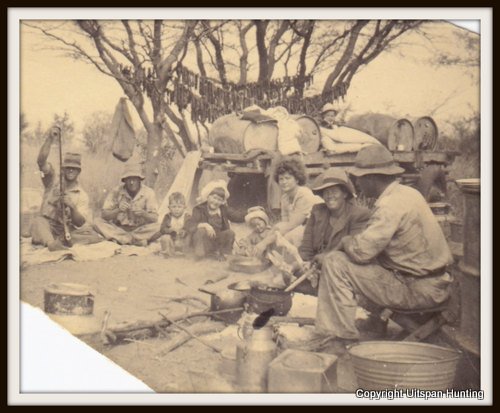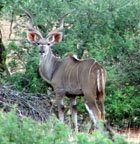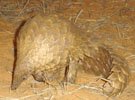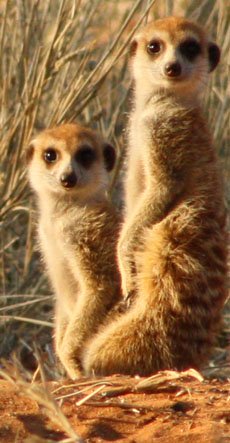For more information about our hunting safaris, don’t hesitate to reach out and contact us!
Shoot! They know we're here....
by Ettiene Landsberg
(Pretoria, South Africa)
Over the years I was taught how to handle, clean and shoot rifles. I mostly went out to bag good Impala and I usually did.
Me and my closest friends now have a yearly ritual where we travel to the most northern part of South Africa to a place called Beitbridge. There are two hunting lodges next to each other which belongs to a guy called Piet.
This year we went there with big expectations because Piet decided not to open the hunting lodges in the season of 2008, this meaning that the game we were after were bigger and there would be more of them.
We arrived on the farm at 6 o'clock in the morning. We were greeted by the PH Barney which is a very interesting and funny man who loves the outdoors like no one I know.
We went out for the first hunt that very morning. I was after a big Blue Wildebeest Bull or an Oryx Bull. Barney dropped me off after about half an hours drive from the camp. My guide and I started walking down the main road which almost cuts the farm in half, searching for the best trail to follow into the great African bushveldt. After about five minutes my guide Petrus stopped as if he stepped on a snake. "Look, a big Warthog..."
I will never say no to a Warthog because of it's meat and I just enjoy the hunt. I had a 9.3x62 rifle with me loaded with 260 grain bullets. Yes I know it's not the best caliber to take out a Warthog.
The shot rang in my ears as the warthog went down on the spot. We dragged the pig to the shade of a Boabab tree and continued on the hunt. After I shot the Warthog I decided that I really wanted to bag a Wildebeest.
Hours went by looking for the Beast of the Bushveldt. We then decided to radio in so that we can go back to the camp. It was the first day anyway and we were successfull already. Barney stopped in the road and as I got into the 1980 Toyota Land Cruiser we saw one Zebra crossing the road at top speed about 300 meters in front of us. And another and another, followed by the a couple of meduim size Wildebeest. A few seconds later a big Wildebeest bull crossed the road. Barney pushed me out of the Toyota and said "You want one anyway. Take him down."
We started stalking the herd of Zebras and Wildebeest. After about twenty minutes, my eye caught a grey figure in the distance. I grabbed Petrus by the shoulder and pulled him down to get cover behind a Mopanie tree. There he was about 180 yards away.
I got ready for the shot but, every time I wanted to take the bull I found myself looking at branches and trees through my scope. I crawled a little to the right to get a clear shot. As I got an opening through the bushes, I felt a firm grip on my ankle, it was Petrus crawling behind me. I looked at him and saw his eyes was serious.
He pulled me closer and whispered in my ear, "Shoot him, the Zebras has seen us, take him, he is a big one". The Wildebeest Bull was facing me and looking straight at me.I aimed for the head because his position did not allow me to take a heart shot from the front.
Whah! The shot went off, dust everywhere as the small herd ran further into the bush. "Did I hit him?" I asked my guide Petrus. "He's down" he replied. As we got closer the big Wildebeest Bull got even bigger as we saw his lifeless body lying in the grass.
I actually hit a bit lower than I wanted but, still I got my trophy Bluewildebeest Bull. He was a Rowland Ward trophy.
Next year I want to bag a big Oryx Bull, hopefully I will have another great African hunting story to share.
Ettiene Landsberg
Comments for Shoot! They know we're here....
|
||
|
||
|
||
|
||
Meaning of "Uitspan"
'Uitspan' is an Afrikaans word that means place of rest.
When the Boer settlers moved inland in Southern Africa in the 1800's, they used ox carts. When they found a spot with game, water and green grass, they arranged their ox carts into a circular laager for protection against wild animals and stopped for a rest.
They referred to such an action of relaxation for man and beast, as Uitspan.

(Picture above of our ancestors.)
Did you know? Greater Southern Kudus are famous for their ability to jump high fences. A 2 m (6.56 ft) fence is easily jumped while a 3 m (9.84 ft) high fence is jumped spontaneously. These strong jumpers are known to jump up to 3.5 m (11.48 ft) under stress. |
Did you know? Some animals have one sense more than man!The flehmen response is a particular type of curling of the upper lip in ungulates, felids and many other mammals. This action facilitates the transfer of pheromones and other scents into the vomeronasal organ, also called the Jacobson's Organ. Some animals have one sense more than man!The flehmen response is a particular type of curling of the upper lip in ungulates, felids and many other mammals. This action facilitates the transfer of pheromones and other scents into the vomeronasal organ, also called the Jacobson's Organ.This behavior allows animals to detect scents (for example from urine) of other members of their species or clues to the presence of prey. Flehming allows the animals to determine several factors, including the presence or absence of estrus, the physiological state of the animal, and how long ago the animal passed by. This particular response is recognizable in males when smelling the urine of a females in heat. |


